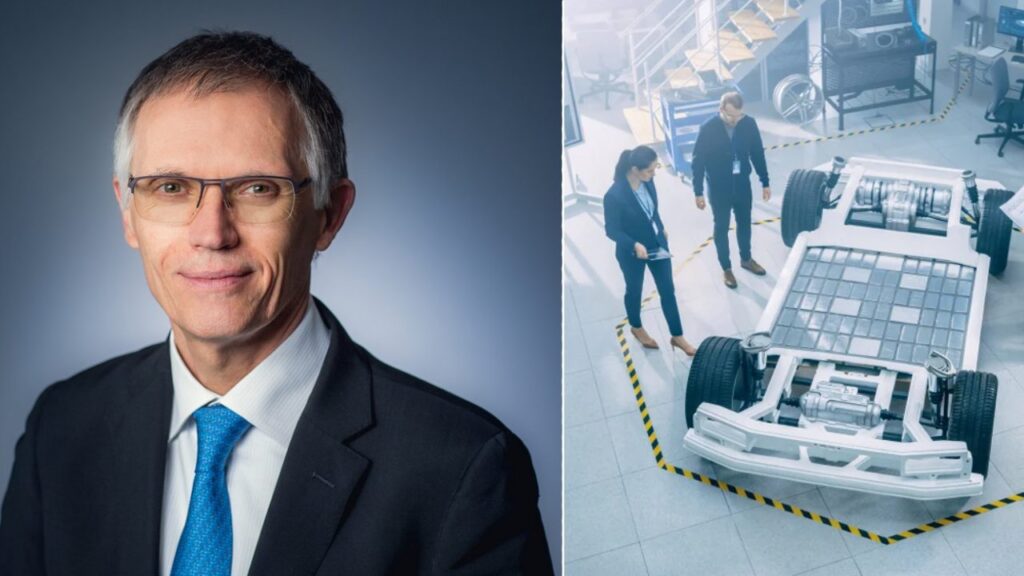The size and weight of EV batteries have been a topic of debate and contention since the inception of electric cars.
Stellantis CEO, Carlos Tavares, wishes to reduce the weight of the EV battery packs by half over the next decade. Now, we know that the EV battery constitutes a major chunk of the overall mass of a vehicle. In EVs, the entire bottom part of the car comprises of the battery. In fact, in some formations like cell-to-body, the top layer of the cell container forms the floor of the EV. The higher the number of cells in an EV battery, the higher its range. But so is the weight of the vehicle.

You might also like: Top 3 Potential Alternatives To Lithium-Ion Batteries For EVs
Stellantis CEO Aims To Cut EV Battery Weight
At the recent Stellantis Freedom of Mobility Forum, Carlos Tavares expressed his concerns regarding the excessive weight of EV batteries. He said, “From an environmental standpoint … I don’t think it makes sense [to have such heavy battery packs]. I think over the next decade we’ll be able to reduce the battery pack weight by 50%, hence reducing by 50% the use of additional raw materials against a conventional vehicle.” This conversation was a part of his interview with Reuters.
Furthermore, he added that the existing EV batteries with a range of around 250 miles (400 km) need approximately 500 kg (~1,100 lbs) of additional raw materials over conventional ICE cars. That is an alarming figure with regard to the environment. With the ongoing R&D in the EV battery technology, the batteries will become more efficient which will, in turn, reduce the weight to offer a similar range.
Stellantis’ EV Plans
Interestingly, the Stellantis CEO didn’t mention any specific way to reduce the weight of the battery by half. Still, it hopes that 100% of sales in Europe will be for all-electric vehicles by 2030. By this time, the conglomerate also estimates that 50% of its sales in the USA will be for BEVs. To put this into concrete numbers, Stellantis aims to sell 5 million BEVs annually by 2030. To achieve this ambitious target, it will have introduced more than 75 BEVs by 2030.
These EVs will make use of 4 vehicle platforms under the SLTA architecture – Small, Medium, Large and Frame. The latter will be a body-on-frame platform for hardcore electric off-roading SUVs. Moreover, it will incorporate 3 drive modules, 2 battery cell chemistries, front-, rear-, and all-wheel drive configurations. Its electric cars will possess a range between 500 km and 800 km (300 miles to 500 miles). Hence, depending on the market and customer preferences, Stellantis will have all sorts of combinations to cater to the demands.

You might also like: Mazda and Panasonic To Work On Cylindrical Cells For EV Batteries
Learn Electric Cars Says
We know that batteries form the most critical component of an EV. This is true for the contribution in the weight of an electric car, as well as the price. That is also the reason why most legacy carmakers and new startups are investing heavily in EV battery technology. In fact, we have reported so many innovative techniques to maximize range and improve the safety and durability of EV batteries without increasing the price too steeply. We are certain that in the coming years, the weight and prices of EV batteries will go down, while the range and efficiency will rise.


Pingback: Stellantis CEO Says Must "Be Chinese Ourselves" To Make EVs
Pingback: CZ Pistols For Sale
Pingback: faw99
Pingback: เช่าจอLED
Pingback: สินเชื่อรถบรรทุก
Pingback: สล็อตออนไลน์ เว็บตรงไม่ผ่านเอเย่นต์
Pingback: Stellantis Launches New STLA Frame Platform w/ 500-Mile Range
Pingback: สล็อตเกาหลี
Pingback: ป้ายแท็ก
Pingback: เล่นเดิมพันกีฬา ต้องนึกถึง LSM99 เท่านั้น
Pingback: สอนสัก
Pingback: is weed legal in nicosia
Pingback: เว็บสล็อตที่ดีที่สุด
Pingback: ฟิลเลอร์
Pingback: รับจัดงานศพ
Pingback: Angthong National Marine Park
Pingback: ผลิตเสื้อยืด
Pingback: Mclaren 720s
Pingback: mostbet app download
Pingback: dark168
Pingback: สมัครสมาชิก ipro666
Pingback: บาคาร่า ufa11k
Pingback: read article
Pingback: girls outcall massage Bangkok
Pingback: winomania
Pingback: clothing manufacturer
Pingback: ใบพัดมอเตอร์
Pingback: เว็บตรงฝากถอนง่าย
Pingback: siamese 31
Pingback: situs toto
Pingback: เกียรติบัตรฟรี
Pingback: Buy Villa Phuket